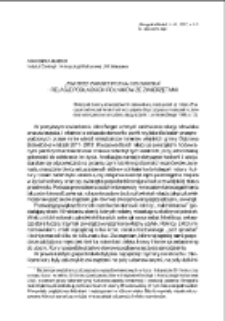- Wyszukaj w całym Repozytorium
- Piśmiennictwo i mapy
- Archeologia
- Baza Młynów
- Nauki przyrodnicze
Wyszukiwanie zaawansowane
Wyszukiwanie zaawansowane
Wyszukiwanie zaawansowane
Wyszukiwanie zaawansowane
Wyszukiwanie zaawansowane

Obiekt
Tytuł: „Zwierzę zawsze pozna człowieka”. Relacje podlaskich rolników ze zwierzętami
Inny tytuł:
Etnografia Polska 61 z. 1-2 (2017)
Wydawca:
Instytut Archeologii i Etnologii Polskiej Akademii Nauk
Miejsce wydania:
Opis:
Typ obiektu:
Abstrakt:
The article is based on field research conducted between 2011 and 2013 amongst people living in villages surrounding the town of Dąbrowa Białostocka in Poland. The main research method was qualitative interviews with female and male farmers. Examined issues included: human-animal relationship and animal subjectivity, attitudes towards mass production of milk and meat, strategies of animals’ death avoidance. I assume that the perception of nature and human-animal relationships changes with time, is socially constructed and grounded in a specific cultural environment. I show that my interlocutors are against mass production as they believe it objectifies animals. The relationship they have with animals within their farm is personal and based on mutual trust. Animals of various species are treated differently, however each individual is treated uniquely, and the relationship is a result of both animal and human personality and effort.
Bibliografia:
Berger John 1999, O patrzeniu, przeł. S. Sikora, Fundacja Aletheia, Warszawa.
Bird-David Nurit 1999, Animism revisited. Personhood, environment, and relational epistemology, Current Anthropology, vol. 40, s. 67–91.
Bukraba-Rylska Izabella 2004, Dziedzictwo kulturowe polskiej wsi – społeczna świadomość, społeczne dyskursy, [w:] I. Bukraba-Rylska (red.), Polska wieś w społecznej świadomości, Instytut Rozwoju Wsi i Rolnictwa PAN, Warszawa.
Ciarka Ryszard 1994, O sposobach zabijania zwierząt, PSL Konteksty, nr 3–4, s. 139–148.
Haładewicz Małgorzata 1994, Perły przed wieprze, PSL Konteksty, nr 3–4, s. 153–154.
Ingold Tim 1994, What is an animal?, Routledge, London and New York.
Ingold Tim 2002, The perceptions of the environment, Routledge, London and New York.
Molly H. Mullin 1999, Mirrors and windows: sociocultural studies of human-animal relationships, Annual Review of Anthropology, vol. 28, s. 201–224.
Mroczkowska Joanna 2014, Transformacja życia w śmierć, a śmierci w pokarm. Społeczny wymiar świniobicia w podlaskiej wsi, Maska. Magazyn antropologiczno-społeczno-kulturowy, Zwierzę, nr 22/2014, AT Wydawnictwo, Kraków, s. 204–213.
Straczuk Justyna 2006, Cmentarz i stół. Pogranicze prawosławno-katolickie w Polsce i na Białorusi, Wydawnictwo Uniwersytetu Wrocławskiego, Wrocław.
Shanklin Eugenia 1985, Sustenance and symbol: anthropological studies of domesticated animals, Annual Review of Anthropology, vol. 14, s. 375–403.
Templewicz Karol 2012, To się chowa do czego się ma zamiłowanie. Analiza habitusu klasy ludowej w jej wariancie wiejskim na przykładzie stosunku do zwierząt, [w:] M. Gdula i P. Sadura (red.), Style życia i porządek klasowy w Polsce, Wydawnictwo Naukowe Scholar, Warszawa.
Czasopismo/Seria/cykl:
Tom:
Zeszyt:
Strona pocz.:
Strona końc.:
Szczegółowy typ zasobu:
Format:
Identyfikator zasobu:
oai:rcin.org.pl:65950 ; 0071-1861
Źródło:
IAiE PAN, sygn. P 325 ; IAiE PAN, sygn. P 326 ; IAiE PAN, sygn. P 327 ; kliknij tutaj, żeby przejść
Język:
Język streszczenia:
Prawa:
Prawa zastrzeżone - dostęp nieograniczony
Zasady wykorzystania:
Digitalizacja:
Instytut Archeologii i Etnologii Polskiej Akademii Nauk
Lokalizacja oryginału:
Biblioteka Instytutu Archeologii i Etnologii PAN
Dostęp:
Kolekcje, do których przypisany jest obiekt:
- Repozytorium Cyfrowe Instytutów Naukowych > Kolekcje Partnerów > Instytut Archeologii i Etnologii PAN > Publikacje Pracowników i Wydawnictwa IAE PAN
- Repozytorium Cyfrowe Instytutów Naukowych > Kolekcje Partnerów > Instytut Archeologii i Etnologii PAN > Publikacje Pracowników i Wydawnictwa IAE PAN > Czasopisma bieżące
- Repozytorium Cyfrowe Instytutów Naukowych > Piśmiennictwo > Czasopisma/Artykuły
- Repozytorium Cyfrowe Instytutów Naukowych > Kolekcje Partnerów > Instytut Archeologii i Etnologii PAN > Publikacje Pracowników i Wydawnictwa IAE PAN > Czasopisma bieżące > Etnografia Polska
Data ostatniej modyfikacji:
2 lut 2022
Data dodania obiektu:
12 lip 2018
Liczba pobrań / odtworzeń:
2044
Wszystkie dostępne wersje tego obiektu:
https://rcin.org.pl./publication/85296
Wyświetl opis w formacie RDF:
Wyświetl opis w formacie RDFa:
Wyświetl opis w formacie OAI-PMH:
| Nazwa wydania | Data |
|---|---|
| Suszko, Agnieszka, 2017, „Zwierzę zawsze pozna człowieka”. Relacje podlaskich rolników ze zwierzętami | 2 lut 2022 |
Obiekty Podobne
Zwierzęta jako przedmiot opresji w Polsce w latach 1945–1970: w poszukiwaniu głównych pól badawczych
Jarosz, Dariusz (1959– )

 INSTYTUT ARCHEOLOGII I ETNOLOGII POLSKIEJ AKADEMII NAUK
INSTYTUT ARCHEOLOGII I ETNOLOGII POLSKIEJ AKADEMII NAUK
 INSTYTUT BADAŃ LITERACKICH POLSKIEJ AKADEMII NAUK
INSTYTUT BADAŃ LITERACKICH POLSKIEJ AKADEMII NAUK
 INSTYTUT BADAWCZY LEŚNICTWA
INSTYTUT BADAWCZY LEŚNICTWA
 INSTYTUT BIOLOGII DOŚWIADCZALNEJ IM. MARCELEGO NENCKIEGO POLSKIEJ AKADEMII NAUK
INSTYTUT BIOLOGII DOŚWIADCZALNEJ IM. MARCELEGO NENCKIEGO POLSKIEJ AKADEMII NAUK
 INSTYTUT BIOLOGII SSAKÓW POLSKIEJ AKADEMII NAUK
INSTYTUT BIOLOGII SSAKÓW POLSKIEJ AKADEMII NAUK
 INSTYTUT CHEMII FIZYCZNEJ PAN
INSTYTUT CHEMII FIZYCZNEJ PAN
 INSTYTUT CHEMII ORGANICZNEJ PAN
INSTYTUT CHEMII ORGANICZNEJ PAN
 INSTYTUT FILOZOFII I SOCJOLOGII PAN
INSTYTUT FILOZOFII I SOCJOLOGII PAN
 INSTYTUT GEOGRAFII I PRZESTRZENNEGO ZAGOSPODAROWANIA PAN
INSTYTUT GEOGRAFII I PRZESTRZENNEGO ZAGOSPODAROWANIA PAN
 INSTYTUT HISTORII im. TADEUSZA MANTEUFFLA POLSKIEJ AKADEMII NAUK
INSTYTUT HISTORII im. TADEUSZA MANTEUFFLA POLSKIEJ AKADEMII NAUK
 INSTYTUT JĘZYKA POLSKIEGO POLSKIEJ AKADEMII NAUK
INSTYTUT JĘZYKA POLSKIEGO POLSKIEJ AKADEMII NAUK
 INSTYTUT MATEMATYCZNY PAN
INSTYTUT MATEMATYCZNY PAN
 INSTYTUT MEDYCYNY DOŚWIADCZALNEJ I KLINICZNEJ IM.MIROSŁAWA MOSSAKOWSKIEGO POLSKIEJ AKADEMII NAUK
INSTYTUT MEDYCYNY DOŚWIADCZALNEJ I KLINICZNEJ IM.MIROSŁAWA MOSSAKOWSKIEGO POLSKIEJ AKADEMII NAUK
 INSTYTUT PODSTAWOWYCH PROBLEMÓW TECHNIKI PAN
INSTYTUT PODSTAWOWYCH PROBLEMÓW TECHNIKI PAN
 INSTYTUT SLAWISTYKI PAN
INSTYTUT SLAWISTYKI PAN
 SIEĆ BADAWCZA ŁUKASIEWICZ - INSTYTUT TECHNOLOGII MATERIAŁÓW ELEKTRONICZNYCH
SIEĆ BADAWCZA ŁUKASIEWICZ - INSTYTUT TECHNOLOGII MATERIAŁÓW ELEKTRONICZNYCH
 MUZEUM I INSTYTUT ZOOLOGII POLSKIEJ AKADEMII NAUK
MUZEUM I INSTYTUT ZOOLOGII POLSKIEJ AKADEMII NAUK
 INSTYTUT BADAŃ SYSTEMOWYCH PAN
INSTYTUT BADAŃ SYSTEMOWYCH PAN
 INSTYTUT BOTANIKI IM. WŁADYSŁAWA SZAFERA POLSKIEJ AKADEMII NAUK
INSTYTUT BOTANIKI IM. WŁADYSŁAWA SZAFERA POLSKIEJ AKADEMII NAUK




































